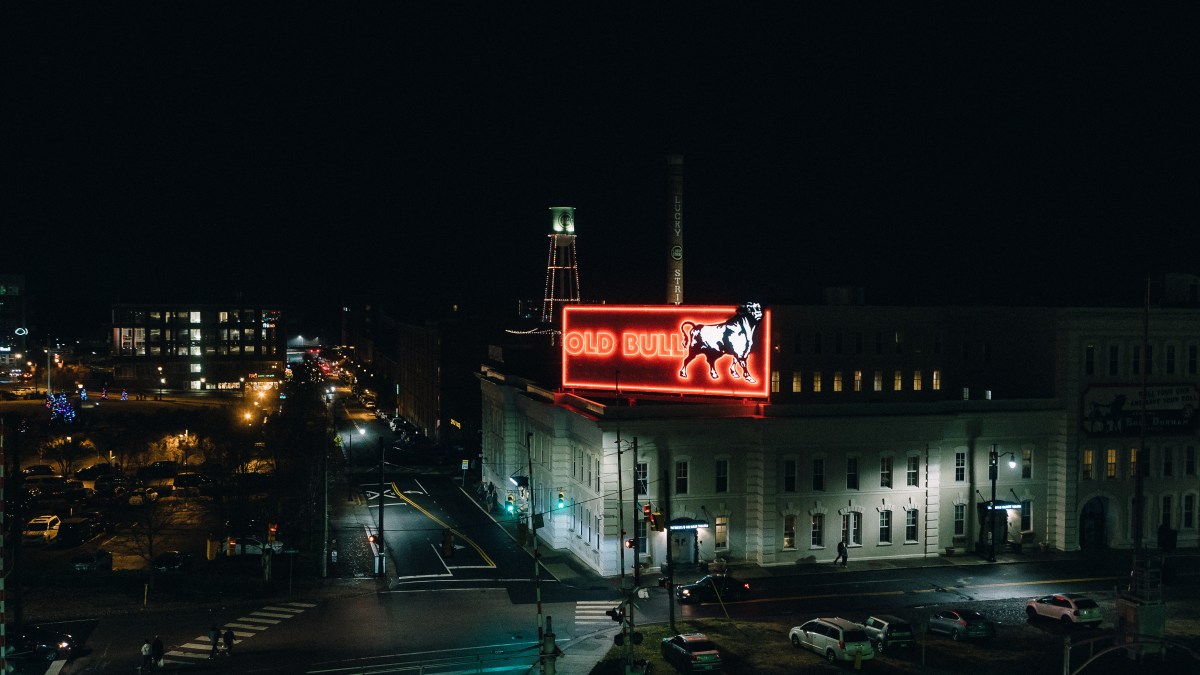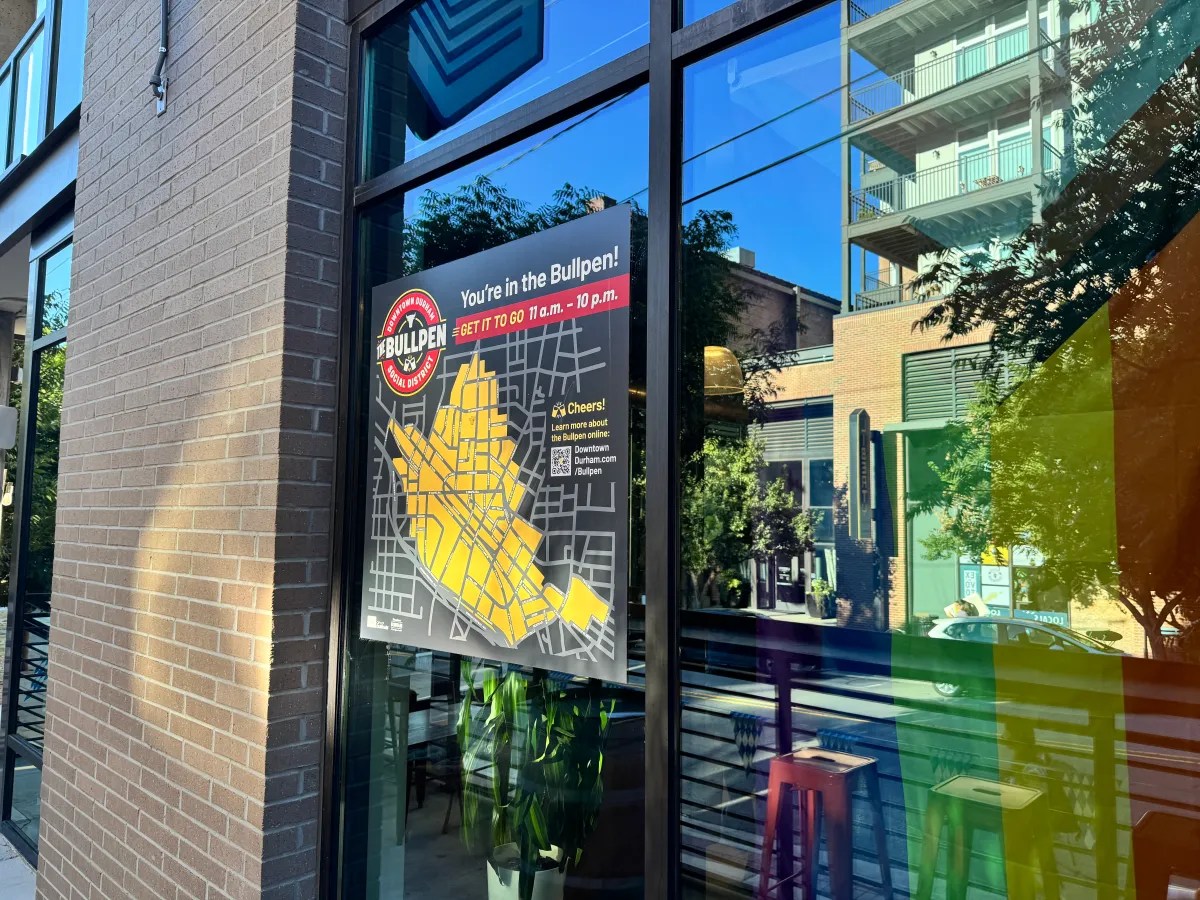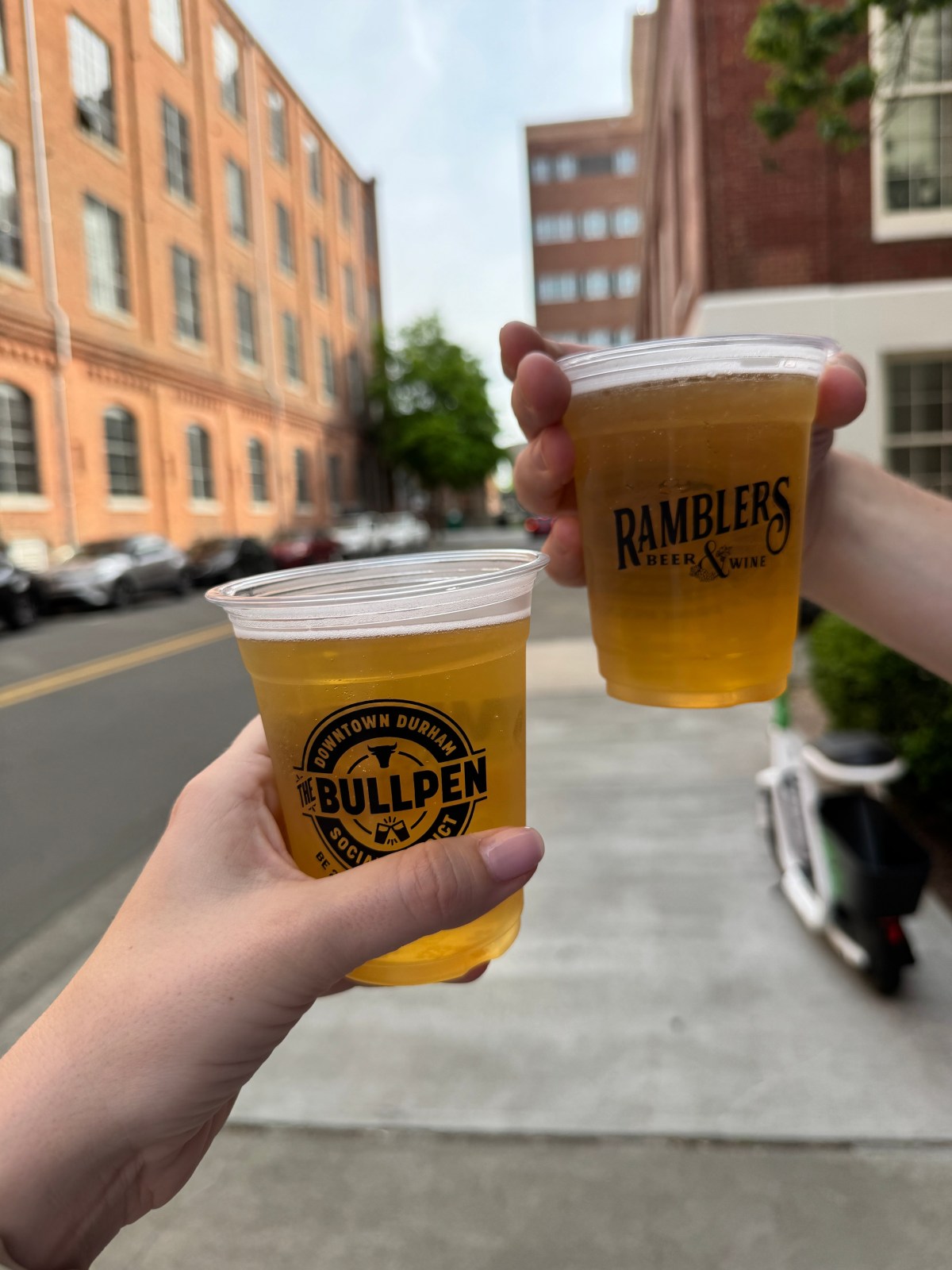Business owner Kat Mathias arranges supplies for the night’s Bob Ross painting class at Impulsive Creativity in Mebane. The store, whose tagline is “Cool Stuff From Weird People,” sells work by more than 50 local artists, much of it with a gothy vibe.
She runs classes in painting, wirework, and stained glass in a back room and hosts game nights. And since July 2024, students have been able to buy a beer next door at the Wooden Nickel Pub, carry it down the sidewalk, and sip it as they create, thanks to the town’s social district, which allows adults to wander from business to business with an open drink in hand.
“I’ve had quite a few people who go to the bars and bring a drink in, especially on nights we play ‘Magic: The Gathering’ or ‘Dungeons and Dragons,’” she said. “Being able to have that aspect of it without me having to have a liquor license is definitely a positive.”
Business was slow when she opened in 2018, and it truly tanked during the pandemic. Now, though, the little downtown is hopping, in part because the population of the bedroom community, located roughly halfway between Durham and Greensboro, has jumped from 15,660 to 20,654, and in part because of efforts like the adoption of a social district.
“Things were pretty bad when I started the business, but traffic has really increased in the past two years, since people have come out since COVID,” she said, “and that helps in just getting people into the shop.”
Mebane paired the launch of its social district with new outside seating areas, trash receptacles, and signage. Mathias could opt out of participating, as it’s voluntary, by hanging a window cling stating that drinks aren’t welcome. But Mathias welcomed the idea of breathing a little life into the town center.
Now, people wander into Mathias’ store, drinks in hand, and chat and browse at ease. They don’t spill, they don’t carouse. They sip and shop.
“People who have moved into the area recently are venturing out and figuring out where the small businesses are,” she said. There’s a brewery and restaurants, and plenty of events. “We’re all trying to keep downtown as a hopping third space. The increase in traffic has been a huge improvement for me.”
A Lifeline
COVID-19 wreaked havoc on downtowns across North Carolina. Restaurant revenue had dropped $2 billion from 2019 to 2020, according to figures provided by the North Carolina Restaurant Association, and more than 60,000 jobs were lost.
Other retail suffered, although there is no hard data on how many stores closed during COVID, according to Andy Ellen, president of the North Carolina Retail Merchants Association. (Restaurants have to have a public health permit, he pointed out, so they’re easier to track.)
In September 2021, lawmakers passed House Bill 890, or the “Bring Business Back to Downtown” bill, to help struggling towns and businesses. Rep. Shelly Willingham (D-Rocky Mount) was one of the co-sponsors.
“We’re all trying to keep downtown as a hopping third space. The increase in traffic has been a huge improvement for me.”
Kat Mathias, Mebane business owner
“The idea was to come up with something that would allow the sale of alcohol in a particular area in a town or county, with some restrictions,” he said. “That allows some of the smaller breweries and distilleries to introduce their products, and it gives the town something to bring people downtown.”
The process of establishing a social district is straightforward. Once a town or city council approves the idea, they file a form with the North Carolina Alcoholic Beverage Control Commission delineating hours and the district’s boundaries. Once that’s approved, they can distribute “drinks welcome” window clings to participating businesses and specially labeled cups to ABC-licensed vendors.
Kannapolis, a city of around 60,000 northeast of Charlotte, was the first to hop on board, opening its district just weeks after the law passed. Its downtown was once owned by its biggest employer, Cannon Mills, and when the mill faltered, so did local businesses, said Annette Privette Keller, director of communications for the city.
The city then purchased the downtown and turned it into an urban park, with wide sidewalks, outdoor dining, public swings, and a fountain that shoots arcs of water over pedestrians. The social district was just one more tool to attract people, she said, and it worked.
“Now you have people go into the Mexican restaurant and get a taco and then get a beer from the brewery next door,” Keller said, “and they enjoy themselves as their kids play in the fountains.”
Since then, both a brewery and a casual steakhouse have opened, as well as dress shops and boutiques and a duckpin bowling alley. Atrium Health Ballpark, home to the Cannon Ballers minor league baseball team, is on the edge of the district, allowing fans to enjoy dinner downtown and carry the remains of their beer or wine as they walk to the game (although they can’t take it into the stadium).
“You see this whole downtown core transformed,” Keller said. “I feel like we’re in a Hallmark movie, so many people out and about, socializing, hanging around outside.”
A Few Reservations
Even with social districts, many downtowns are still struggling to revive foot traffic and business to pre-pandemic levels. Durham, which is home to several social districts, has had a string of restaurant closures–50 restaurants and bars have closed since 2020, according to data from Downtown Durham, Inc. More people working remotely and not even coming downtown has exacerbated the problem.
Social districts help, said Seth Gross, owner of Bull City Burger and Brewery, but they’re not a silver bullet.
“To me, it’s sort of like a cherry on top,” Gross said. “It adds to the joy of being downtown and people being able to travel around, but it’s not a huge percentage of our sales. I thought it would be more, but it’s more like a handful of walking beers a week.”

Since 2020, 95 new restaurants and bars have opened in Durham; 49 were after the inception of the social districts.
Social districts in 64 municipalities are now registered with the state’s ABC Commission. But some of North Carolina’s largest cities have held out.
Winston-Salem is one that has not approved a social district, in large part because its police department is spread too thin, said city Economic Development Director Ken Millett. Officials worry a social district would take officers away from other parts of the city.
Jason Thiel, president of the Downtown Winston-Salem Partnership, has given it a lot of thought. “We’ve had a number of bar owners who want to try it, but it just doesn’t get past the police department,” he said.
The potential for public drunkenness and open containers in parks and on streets is a concern, especially given problems with the city’s unhoused population. “If you provide this liberty to the population, it’s going to be enjoyed by everyone,” Thiel said.
Still, he would support a social district and likes the idea of testing it out during special events like festivals or concerts, such as the annual Gears & Guitars cycling and music celebration or the Hispanic League Fiesta. While different from social districts, the ABC commission does issue permits for special events. Ellen from the North Carolina Retail Merchants Association said initial concerns about public drunkenness and its management have been overblown.
“When some of the public hearings were held, it was always a worry that ‘my town is going to turn into Mardi Gras or Bourbon Street,’” he said, “but that has not come to fruition at all.”

In Greensboro, city council members who are against alcohol consumption overall have stymied efforts to expand the social district and don’t see why the city would want to promote drinking, said Rob Overman, vice president of Downtown Greensboro, Inc.
In Asheville, city leaders hadn’t meaningfully considered a social district designation until recently, said Councilmember Bo Hess.
“We haven’t needed a social district,” he said. “We have been an active, lively place that people have loved to visit.”
But after the destruction from Hurricane Helene, there’s more interest. Hess is enthusiastic about the idea but also wants more concerts, conferences, and sporting events to rejuvenate downtown, which bring in hundreds of thousands of dollars in additional income for local small businesses.
“We need to move away from being a beer city to more of an event city,” he said. Where they might put it and how large its boundaries would be is also up for debate. “In my mind, it’s not about where we start,” Hess said. “We just have to start somewhere.”
No Regrets
In the last four years, more than 3,300 new food and drink establishments have opened across North Carolina, according to the North Carolina Restaurant and Lodging Association. While social districts are only one part of revitalization plans, many enthusiasts say they’ve made a difference.
“Social districts have been helpful because they helped restore consumer confidence and have brought people back downtown, giving restaurants, breweries, taprooms, and small-format food businesses an extra lifeline,” said Lynn Minges, president and CEO of the Restaurant and Lodging Association.
Small, rural towns credit social districts with revamping otherwise flagging downtown centers. Business owners in Wendell, a town of just under 17,000 in eastern Wake County, claim they have created a better sense of community and collaboration, said Roger Peterson, executive director of the town’s Chamber of Commerce.
“You see this whole downtown core transformed. I feel like we’re in a Hallmark movie, so many people out and about, socializing, hanging around outside.”
Annette Privette Keller, director of communications for Kannapolis
“Someone gave the example that if the kids are outside playing, you can go get your beverage and stand there and watch and talk with other people,” he said. “Whereas if the social district wasn’t in place, you’d have to cut out one or the other activity.”
The town’s annual Harvest Festival, held each October, brings in about 10,000 people. There’s an inflatable slide, miniature horses, and a stage for musicians, youth performers, and the East Wake Strutters Line Dance Group. There are vendors and food trucks, and a parade with marching bands, scout troops, athletic teams, and kids on decorated bicycles.
“Before the social district, we pulled an ABC permit and set up a beer garden, just a small fenced-in area where you could watch the band,” Peterson said. They don’t have to do that anymore.
Bringing Life Back to Downtown
When Robin Davis bought a historic brick building in the Stanly County town of Norwood, population 2,500, in 2017, it had about three businesses and at least 18 empty buildings in its core business district.
She opened a small coffee shop and started exploring rural revitalization projects elsewhere. She soon formed a nonprofit, the Central Business District Group, and started talking with locals about how to attract businesses.


“One of the first things that caught our eye was this little clip in the newspaper about Kannapolis,” she said. “I saw that this was an opportunity to use it as a catalyst to add something to our downtown that maybe other people didn’t have and to be one of the first to get it implemented.”
A primary goal was to draw a restaurant to downtown, and a social district would help. The town council agreed, approving it in December 2021.
“This is a low-barrier, high-impact rural revitalization tool,” she said. “It has changed the public perception of downtown Norwood, attracting commerce and creativity.”
It’s a fantastic tool for economic development, she said. “We literally just showed a building I own, and that was one of the first questions: ‘Y’all have a social district here, right?’”
Norwood’s annual Arbor Day Festival traditionally drew “a lot of older people listening to older music and sitting in lounge chairs,” she said. The social district changed the vibe: “We’ve seen the age demographic of maybe 18 to 45 explode at our festivals!”
It has also met the group’s primary goal. Lantern Sushi and Bravo’s Mexican Grill have since opened downtown, and there’s another restaurant under discussion.
“When I opened my building, almost all of Main Street was empty,” Davis said. Now, “People are struggling to find spaces, and as soon as something closes down, we have something coming in right behind it.”
To comment on this story, email [email protected].
